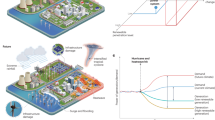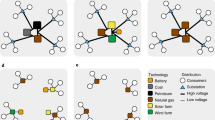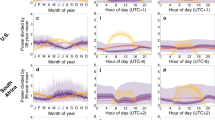Abstract
Climate induced extreme weather events and weather variations will affect both the demand of energy and the resilience of energy supply systems. The specific potential impact of extreme events on energy systems has been difficult to quantify due to the unpredictability of future weather events. Here we develop a stochastic-robust optimization method to consider both low impact variations and extreme events. Applications of the method to 30 cities in Sweden, by considering 13 climate change scenarios, reveal that uncertainties in renewable energy potential and demand can lead to a significant performance gap (up to 34% for grid integration) brought by future climate variations and a drop in power supply reliability (up to 16%) due to extreme weather events. Appropriate quantification of the climate change impacts will ensure robust operation of the energy systems and enable renewable energy penetration above 30% for a majority of the cities.
This is a preview of subscription content, access via your institution
Access options
Access Nature and 54 other Nature Portfolio journals
Get Nature+, our best-value online-access subscription
$29.99 / 30 days
cancel any time
Subscribe to this journal
Receive 12 digital issues and online access to articles
$119.00 per year
only $9.92 per issue
Buy this article
- Purchase on Springer Link
- Instant access to full article PDF
Prices may be subject to local taxes which are calculated during checkout






Similar content being viewed by others
Data availability
The data relevant to the energy and climate models not found in the in Supplementary Notes 1–3 are available from the corresponding author upon reasonable request. The raw climate data are available through Coordinated Regional Climate Downscaling Experiment (http://www.cordex.org/). Source data for Figs. 3–6 are provided with the paper.
Code availability
The computational code is available from the corresponding author for academic purposes upon reasonable request.
References
IPCC Climate Change 2014: Synthesis Report (eds Core Writing Team, Pachauri, R. K. & Meyer L. A.) (IPCC, 2014).
IPCC Managing the Risks of Extreme Events and Disasters to Advance Climate Change Adaptation: Special Report of the Intergovernmental Panel on Climate Change (Cambridge Univ. Press, 2012); https://doi.org/10.1017/CBO9781139177245.
The Global Risks Report 2016 (World Economic Forum, 2016); https://www.weforum.org/reports/the-global-risks-report-2016/.
World Urbanization Prospects: The 2018 Revision (United Nations, Department of Economic and Social Affairs, 2019).
Perera, A. T. D., Nik, V. M., Mauree, D. & Scartezzini, J.-L. Electrical hubs: an effective way to integrate non-dispatchable renewable energy sources with minimum impact to the grid. Appl. Energy 190, 232–248 (2017).
Nik, V. M. & Sasic Kalagasidis, A. Impact study of the climate change on the energy performance of the building stock in Stockholm considering four climate uncertainties. Build. Environ. 60, 291–304 (2013).
Stern, P. C., Sovacool, B. K. & Dietz, T. Towards a science of climate and energy choices. Nat. Clim. Change 6, 547–555 (2016).
Pryor, S. C., Schoof, J. T. & Barthelmie, R. J. Winds of change?: Projections of near-surface winds under climate change scenarios. Geophys. Res. Lett. 33, L11702 (2006).
Sailor, D. J., Smith, M. & Hart, M. Climate change implications for wind power resources in the Northwest United States. Renew. Energy 33, 2393–2406 (2008).
Wang, B., Ke, R.-Y., Yuan, X.-C. & Wei, Y.-M. China’s regional assessment of renewable energy vulnerability to climate change. Renew. Sustain. Energy Rev. 40, 185–195 (2014).
Auffhammer, M., Baylis, P. & Hausman, C. H. Climate change is projected to have severe impacts on the frequency and intensity of peak electricity demand across the United States. Proc. Natl Acad. Sci. USA 114, 1886–1891 (2017).
Sharifi, A. & Yamagata, Y. Principles and criteria for assessing urban energy resilience: a literature review. Renew. Sustain. Energy Rev. 60, 1654–1677 (2016).
Nik, V. Hygrothermal Simulations of Buildings Concerning Uncertainties of the Future Climate. PhD thesis, Chalmers Univ. of Technology (2012).
Panteli, M. & Mancarella, P. Influence of extreme weather and climate change on the resilience of power systems: impacts and possible mitigation strategies. Electr. Power Syst. Res. 127, 259–270 (2015).
Dowling, P. The impact of climate change on the European energy system. Energy Policy 60, 406–417 (2013).
IPCC Climate Change 2013: The Physical Science Basis (eds Stocker, T. F. et al.) (Cambridge Univ. Press, 2013).
Herrera, M. et al. A review of current and future weather data for building simulation. Build. Serv. Eng. Res. Technol. 38, 602–627 (2017).
Hall, I. J., Prairie, R. R., Anderson, H. E. & Boes, E. C. Generation of a typical meteorological year. In Proc. Conference: Analysis for solar heating and cooling (Office of Scientific and Technical Information, 1978); http://www.osti.gov/scitech/biblio/7013202
Nik, V. M. Making energy simulation easier for future climate – synthesizing typical and extreme weather data sets out of regional climate models (RCMs). Appl. Energy 177, 204–226 (2016).
Mavromatidis, G., Orehounig, K. & Carmeliet, J. Comparison of alternative decision-making criteria in a two-stage stochastic program for the design of distributed energy systems under uncertainty. Energy 156, 709–724 (2018).
Zhao, C. & Guan, Y. Unified stochastic and robust unit commitment. IEEE Trans. Power Syst. 28, 3353–3361 (2013).
Baringo, A. & Baringo, L. A stochastic adaptive robust optimization approach for the offering strategy of a virtual power plant. IEEE Trans. Power Syst. 32, 3492–3504 (2017).
Samuelsson, P. et al. The Surface Processes of the Rossby Centreregional Atmospheric Climate Model (RCA4) (Swedish Meteorological and Hydrological Institute, 2015); https://www.smhi.se/en/publications/the-surfaceprocesses-of-the-rossby-centreregional-atmospheric-climate-modelrca4-1.89801.
Hellström, C., Chen, D., Achberger, C. & Räisänen, J. Comparison of climate change scenarios for Sweden based on statistical and dynamical downscaling of monthly precipitation. Clim. Res. 19, 45–55 (2001).
Perera, A. T. D., Nik, V. M., Mauree, D. & Scartezzini, J.-L. An integrated approach to design site specific distributed electrical hubs combining optimization, multi-criterion assessment and decision making. Energy 134, 103–120 (2017).
Celik, A. N. Effect of different load profiles on the loss-of-load probability of stand-alone photovoltaic systems. Renew. Energy 32, 2096–2115 (2007).
Ji, L., Niu, D. X. & Huang, G. H. An inexact two-stage stochastic robust programming for residential micro-grid management-based on random demand. Energy 67, 186–199 (2014).
Bagheri, A., Zhao, C. & Guo, Y. Data-driven chance-constrained stochastic unit commitment under wind power uncertainty. In 2017 IEEE Power & Energy Society General Meeting 1–5 (IEEE, 2017); https://doi.org/10.1109/PESGM.2017.8273948.
Narayan, A. & Ponnambalam, K. Risk-averse stochastic programming approach for microgrid planning under uncertainty. Renew. Energy 101, 399–408 (2017).
Agustín, J. L. B. & López, R. D. Efficient design of hybrid renewable energy systems using evolutionary algorithms. Energy Convers. Manag. 50, 479–489 (2010).
Soroudi, A. & Amraee, T. Decision making under uncertainty in energy systems: state of the art. Renew. Sustain. Energy Rev. 28, 376–384 (2013).
Fouskakis, D. & Draper, D. Stochastic optimization: a review. Int. Stat. Rev. 70, 315–349 (2002).
Beyer, H.-G. & Sendhoff, B. Robust optimization – a comprehensive survey. Comput. Methods Appl. Mech. Eng. 196, 3190–3218 (2007).
Perera, A. T. D., Attalage, R. A., Perera, K. K. C. K. & Dassanayake, V. P. C. Converting existing internal combustion generator (ICG) systems into HESs in standalone applications. Energy Convers. Manag. 74, 237–248 (2013).
Acknowledgements
We thank E. Kjellström, G. Strandberg and G. Nikulin from the Rossby Centre at the Swedish Meteorological and Hydrological Institute (SMHI) for their help with the climate data and assessment. We thank E. Davin of ETH Zurich for his interesting insights in relation to this study. We also thank K. Javanroodi for creating the map of Sweden for this publication. This work was supported by the Swiss Competence Center for Energy Research SCCER FEEB&D of the Swiss Innovation Agency Innosuisse (CTI.2014.0119), the Swedish Research Council for Sustainable Development (Formas 2016-20123), the Assistant Secretary for Energy Efficiency and Renewable Energy, Office of Building Technologies of the United States Department of Energy (Contract no. DE-AC02-05CH11231) and the Swedish national strategic research program BECC and 398 MERGE. Some of the computations were performed on resources provided by the Swedish National Infrastructure for Computing (SNIC) at the National Supercomputer Centre in Sweden (NSC).
Author information
Authors and Affiliations
Contributions
A.T.D.P., V.M.N., D.C., J.L.S. and T.H. designed the research. V.M.N. synthesized the climate data and conducted the uncertainty analysis and impact assessment of climate change on energy demand and renewable generation. A.T.D.P. developed the energy system optimization algorithm and conducted the energy system analysis. A.T.D.P., V.M.N., D.C., J.L.S. and T.H. wrote the manuscript.
Corresponding author
Ethics declarations
Competing interests
The authors declare no competing interests.
Additional information
Publisher’s note Springer Nature remains neutral with regard to jurisdictional claims in published maps and institutional affiliations.
Supplementary information
Supplementary Information
Supplementary Notes 1–10, Figs. 1–7, Table 1 and refs. 1–41.
Source data
Source Data Fig. 3
Scatter plot.
Source Data Fig. 4
Scatter and box plot.
Source Data Fig. 5
Scatter plot.
Source Data Fig. 6
Scatter plot.
Rights and permissions
About this article
Cite this article
Perera, A.T.D., Nik, V.M., Chen, D. et al. Quantifying the impacts of climate change and extreme climate events on energy systems. Nat Energy 5, 150–159 (2020). https://doi.org/10.1038/s41560-020-0558-0
Received:
Accepted:
Published:
Issue Date:
DOI: https://doi.org/10.1038/s41560-020-0558-0
This article is cited by
-
Extreme weather events on energy systems: a comprehensive review on impacts, mitigation, and adaptation measures
Sustainable Energy Research (2024)
-
Projected income data under different shared socioeconomic pathways for Washington state
Scientific Data (2024)
-
Resilience of renewable power systems under climate risks
Nature Reviews Electrical Engineering (2024)
-
Phosphonate-based iron complex for a cost-effective and long cycling aqueous iron redox flow battery
Nature Communications (2024)
-
A Bayesian Based Multi-stage Type-2-fuzzy Game and Interval-stochastic Programming Method for Planning Basin Energy-water-climate Nexus System
Water Resources Management (2024)



